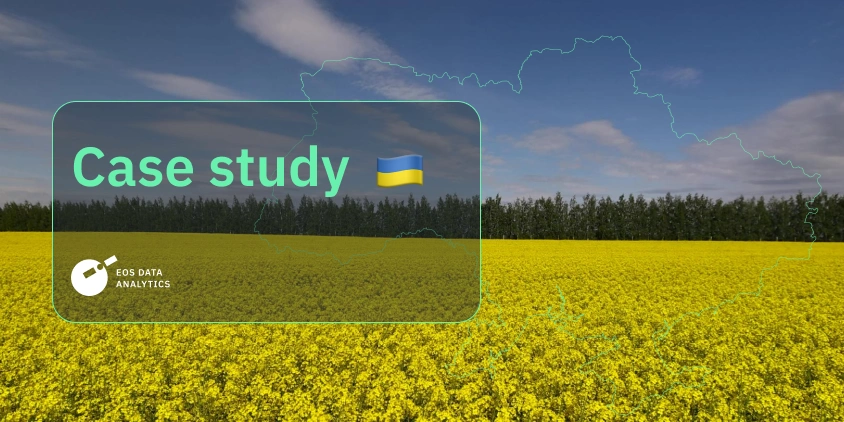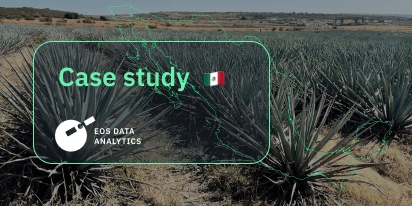
EOSDA Solutions Accelerate Research And Development
Sustainable agriculture is rapidly advancing all over the world, including in Ukraine. One research company in the region has been at the forefront, developing new plant hybrids, plant protection products, biostimulants, and special bacteria to aid farmers in soil management, reducing greenhouse gas emissions, and increasing crop yields.
However, the research and development of these products demand substantial effort and advacned tools. Until 2022, this company relied on drones for monitoring their experimenta fields. However, with the outbreak of war, drone flights faced significant restrictions. As a result, by the end of 2022, the agronomy team in Ukraine shifted to satellite monitoring.
In just one year, the EOSDA Crop Monitoring platform has proven invaluable, not only for interim analysis of field productivity and assessing the impact of the company’s products but also for selecting test sites and advancing the company’s long-term goals in Ukraine.
| Challenge | The outbreak of full-scale war in Ukraine restricted drone flights, hindering the company’s ability to monitor experimental fields and evaluate product effectiveness. |
| Solution | The agronomy team shifted to satellite monitoring using the EOSDA Crop Monitoring platform, enabling comprehensive analysis and field selection. |
| Outcome | The company optimized field trials, improved product performance assessment, and strengthened its commitment to sustainable agricultural practices. |
Company Overview
This case studdy features a large research and development company specializing in agriculture and investing up to a billion dollars annually in developing related technologies. With a team of agri-scientists leveraging over two centuries of research experience, the company consistently innovates in the agricultural sector.
The company is particularly committed to sustainable agriculture. Its long-term objectives include educating farmers on new farming methods, reducing greenhouse gas emissions while enhancing yields, and improving soil conditions.
Currently, the agronomy team’s activities focus on two main areas:
- Developing new products and testing them at their own agricultural test sites.
- Providing support and advice to farmers implementing the latest technologies and products, such as seeds and crop protection solutions, in their fields.
In both areas, satellite monitoring has been instrumental in optimizing certain processes. When the team discovered the EOSDA Crop Monitoring platform, they quickly adopted the technology for their operations in Ukraine.
Tasks: Landfill Selection And Performance Analysis
The aforementioned company has testing grounds in every region and soil-climatic zone of Ukraine. When testing a new hybrid or protection product, selecting the optimal field (or set of fields) is crucial. This selection process considers field diversity, which can lead to heterogeneous results, and the historical characteristics of the fields. Such knowledge helps the company predict the expected behavior of selected crops in different test sites.
To analyze the fields, the company’s specialists used the Zoning and VRA Maps functions in EOSDA Crop Monitoring. These functions were applied not only to current satellite images but also to historical data. This approach allowed the identification of homogeneous areas on the test sites, suitable for various experiments.
A similar approach is used when advising farmers. Predicting the effectiveness of a specific crop protection product, the performance of a growth stimulator, or the yield of a hybrid is essential for them.
As one of the company’s digital solutions development specialists mentioned, the effectiveness of their products often becomes apparent only at the harvest stage. However, using satellite images and VRA maps allows for the observation of intermediate results and vegetation changes, making it a unique tool for tracking crop development.
The agronomy team employs a wide range of technologies, including smart penetrometers, testers, cob moisture meters, and, predominantly, drones. Today, Ukraine boasts one of the largest fleets in the world, allowing crop protection products to be applied via unmanned vehicles. However, the introduction of martial law severely restricted, drone flights, prompting the agricultural team to seek alternative methods for assessing crop vegetative dynamics.
Solutions: Zoning, Performance Maps, NDVI
In 2023, the company’s agricultural team utilized the EOSDA Crop Monitoring platform to select fields across Ukraine. Satellite monitoring provided a comprehensive history of the fields, which was a key criterion for approving sites for further research and testing.
Recently, the company added a new product to its portfolio: a live bacterium that captures nitrogen from the air, facilitating its uptake into the plant. This bacterium is applied foliarly and resides within the plant, making its effect visually imperceptible. To track its impact over the course of a year, the agronomy team used EOS Data Analytics’ satellite monitoring capabilities to calculate and analyze the Normalized Difference Vegetation Index (NDVI).
NDVI measures the density of green vegetation in an image. An increase in the NDVI index compared to the previous year likely indicates the bacterium’s effect. While the primary criterion for the bacterium’s success is yield, visualizing NDVI dynamics in crop monitoring software has proven to be a convenient additional method for evaluating product effectiveness.
The company also used satellite monitoring to study and demonstrate the performance of its other products, such as biostimulants and plant protection products. The effectiveness of these products can vary under different conditions and in various climatic zones and may not be visually evident during the growing season. In these cases, satellite monitoring allowed the agronomy team to showcase the product’s performance to farmers effectively.
Outcomes: Situational Productivity And Future Sustainability Of Agricultural Practices
In 2023, with the assistance of EOSDA Crop Monitoring, the company successfully optimized field selection for its trials and experiments in Ukraine. This improvement also enhanced communication with farmers using its products.
However, the partnership between the two companies extends beyond these immediate changes. Both organizations are committed to promoting sustainable agricultural practices. Satellite monitoring plays a crucial role here, providing a reliable means to track vegetation dynamics, yields, soil conditions, and greenhouse gas emissions.
Looking ahead, the company is keenly interested in the next advancements of the EOSDA Crop Monitoring platform. They are particularly excited about the upcoming disease forecasting tool and are exploring potential benefits from solar radiation and evapotranspiration tracking.
About the author:
Maksym Sushchuk is at the forefront of realizing EOSDA's vision to make space tech a global driver of sustainability on Earth. He has over 15 years of experience in journalism and content creation for prominent Ukrainian startups, charitable funds and ESG businesses. As Head and Co-founder of PR Army Maxim brings attention to the human and social tolls of the aggression against Ukraine.
Recent articles

Digital Tools Improve Soil Health And Yields In Mexico
EOSDA and ITTA supported a Guanajuato farm with contour-line planning, monitoring tools, and practical guidance to reduce soil erosion and improve yields in the long run.

Analyze 2025 & Plan Your Best Year Yet: LandViewer Christmas Offer
It’s the most wonderful time of the year! The Christmas holidays are here, and so is your chance to analyze 2025 and plan a prosperous 2026 with more affordable Pro plans in LandViewer.

EOSDA Models Climate Change Impact On Sugarcane Yields
EOSDA modeled future temperature, rainfall, and other climate impacts on Veracruz sugarcane. The results help growers plan long-term adaptation strategies, including timing, varieties, and irrigation.